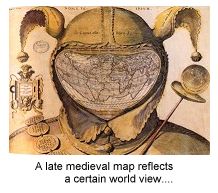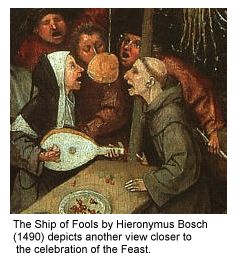
Gothic Design
Learn More.
| HOME Feature Articles Stone Carver's Tour Virtual Cathedral Cathedral Tours Gothic Field Guide GOTHIC GEOMETRY Virtual Abbey Medieval Art Tours Castle Tours Links Resources About The Site FAQ |
|
Perhaps a medieval Christmas was more serious than the commercial celebration many of us have come to know. However,
a medieval New Year's Day was The celebrations usually began on the first of the year, every year until the 16th century — when the party was finally called off forever... Well, almost. Its origins could be traced back to pre-Christian Rome and the harvest festival honoring the harvest god Saturn. During the Roman Saturnalia all class distinctions were abolished, with slaves and their masters switching roles, and laws that normally governed sensible behavior virtually suspended. During the mock services, prayer responses that would have normally included an 'amen' were substituted by a hearty 'hee-haw'.
In medieval times, most Europeans adopted the Roman taste for a
good time by electing a Lord of Misrule, or King of Fools. This
harlequin king went by many names: King of the Bean in England,
the Abbot of Unreason in Scotland, the Abbe de la Malgouveme
in France. All had the power to call people to disorder. In some places the Festival of the Ass was commemorated. A young girl with babe in arms entered a church riding an ass or donkey. During the mock services, prayer responses that would have normally included an 'amen' were substituted by a hearty 'hee-haw'. Parisians had a particularly infamous reputation. By the 15th century, an embarassed Catholic Church finally clamped down on the 'monstrous' celebrations in which, centuries later, Victor Hugo wrote of Quasi Modo as the King of Fools in Hunchback of Notre Dame. In fact, songwriters apparently did their homework for the recent Disney animation, capturing the spirit of the feast with these lyrics: Come
one, come all! The end was near when the Protestant Reformation finally condemned all such politically incorrect excesses. One edict in particular claimed that they were 'rather the unlawful superstition of gentilite [paganism] than the pure and sincere religion of Christe' - and stricter laws forbidding the buffoonery followed in the 1600's. The party was over. But in many ways it continues today some 500 years later, in modern scenes played out in the U.S. at the Mummer's Parade in Philadelphia, and in New York's Times Square. Go (and as tradition dictates) have fun... Happy Feast of Fools.
More
resources on The Feast of Fools:
|
Sponsored
Links
copyright © 2017
 the one time of year EVERYBODY jumped at the chance to let loose
at the medieval Feast of Fools celebration.
the one time of year EVERYBODY jumped at the chance to let loose
at the medieval Feast of Fools celebration. Cross
dressing, bawdy songs, drinking to excess, and gambling on the church
altar were only a few of the wanton acts reported.
Cross
dressing, bawdy songs, drinking to excess, and gambling on the church
altar were only a few of the wanton acts reported.